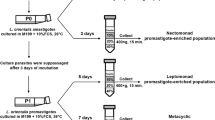Summary
Twelve different established cell-lines were used in attempts to cultivate the erythrocytic stages ofPlasmodium berghei, P. vinckei vinckei, P. coatneyi orP. knowlesi. Intracellular parasites were seen in only mouse Leydig cell testicular tumor (LCT) cultures inoculated with red cells infected withP. berghei. Intracellular parasites were present at 15 to 96 h after inoculation, being most numerous at 36 h. Most intracellular stages were rings, trophozoites, schizonts and merozoites; gametocytes were few in number and present only at 36 and 48 h. Intracellular parasites were normal in general morphology and staining characteristics at 15 to 48 h, but were abnormal after 72 h. Infected host cells exhibited progressive nuclear and cytoplasmic degenerative changes, which ultimately resulted in death of the cell. Uninfected cells appeared normal. The ability of parasites in LCT cultures to produce infections upon injection into mice was similar to that obtained with control cultures without LCT cells.
Similar content being viewed by others
References
Ball, G. H., Chao, J.: The complete development of the sporogenous stages ofHepatozoon rarefaciens cultured inCulex pipiens cell line. J. Parasit.59, 513–515 (1973)
Beaudoin, R. L., Strome, C. P. A., Clutter, W. G.: A tissue culture system for the study of drug action against the tissue phase of malaria. Milit. Med.134, 979–985 (1969)
Beaudoin, R. L., Strome, C. P. A., Clutter, W. G.: Cultivation of avian malaria parasites in mammalian liver cells. Exp. Parasit.36, 355–359 (1974)
Brown, K. N., Brown, I. N., Hills, L. A.: Immunity to malaria. I. Protection againstPlasmodium knowlesi shown by monkeys sensitized with drug-suppressed infections or by dead parasites in Freund's adjuvant. Exp. Parasit.28, 304–317 (1970)
Cabrera, E. J., Speer, C. A., Schenkel, R. H., Barr, M. L., Silverman, P. H.: Delayed dermal hypersensitivity in Rhesus monkeys (Macaca mulatta) immunized againstPlasmodium knowlesi. Z. Parasitenk. (1976) (in press)
Chao, J., Ball, G. H.: In vitro culture of the vector phase of snake hemogregarines in mosquito cell lines. J. Parasit.58, 148–152 (1972)
Davis, A. G., Huff, C. G., Palmer, T. T.: Procedures for maximum production of exoerythrocytic stages ofPlasmodium fallax in tissue culture. Exp. Parasit.19, 1–8 (1966)
Fajardo, L. F.: Malaria parasites in mammalian platelets. Nature (Lond.)243, 298–299 (1973)
Hendricks, L. D., Fayer, R.: Development ofHepatozoon griseisciuri in cultured squirel cells. J. Protozool.20, 550–554 (1973)
Kaltenbach, J. P., Kaltenbach, N., Lyons, W. E.: Nigrosin as a dye for differentiating live and dead ascites cells. Exp. Cell Res.15, 112–117 (1958)
McGhee, R. B.: Infections of mammalian erythrocytes by the avian malaria parasite,Plasmodium lophurae. Proc. Soc. exp. Biol. (N.Y.)71, 92–93 (1949)
McGhee, R. B.: The ability of the avian malaria parasite,Plasmodium lophurae, to infect erythrocytes of distantly related species of animals. Amer. J. Hyg.52, 42–47 (1950)
Mitchell, G. H., Butcher, G. A., Cohen, S.: Merozoite vaccination againstPlasmodium knowlesi malaria. Immunology29, 397–407 (1975)
Rosales-Ronquillo, M. C., Nienaber, G., Silverman, P. H.:Plasmodium berghei ookinete formation in a nonvector cell line. J. Parasit.60, 1039–1040 (1974)
Rosales-Ronquill, M. C., Silverman, P. H.: In vitro ookinete development of the rodent malarial parasite,Plasmodium berghei. J. Parasit.60, 819–824 (1974)
Schenkel, R. H., Simpson, G. L., Silverman, P. H.: Vaccination of Rhesus monkeys (Macaca mulatta) againstPlasmodium knowlesi by the use of nonviable antigen. Bull. Wld Hlth Org.48, 597–604 (1973)
Simpson, G. L., Schenkel, R. H., Silverman, P. H.: Vaccination of Rhesus monkeys against malaria by use of sucrose density gradient fractionations ofPlasmodium knowlesi. Nature (Lond.)247, 304–306 (1974)
Speer, C. A., Silverman, P. H., Barr, M. L.: Ultrastructure study ofPlasmodium knowlesi antigen used in vaccination of Rhesus monkeys. J. Protozool.23, 431–442 (1976)
Speer, C. A., Silverman, P. H., Schiewe, S. G.: Cultivation of the erythrocytic stages ofPlasmodium berghei in primary bone marrow cells. J. Parasit. (1976) (in press)
Author information
Authors and Affiliations
Additional information
Supported by the Agency for International Development, U.S. Department of State Contract No. AID/csd-3689.
Rights and permissions
About this article
Cite this article
Speer, C.A., Silverman, P.H. & Schiewe, S.G. Cultivation of the erythrocytic stages ofPlasmodium berghei in Leydig cell tumor cultures. Z. F. Parasitenkunde 50, 237–244 (1976). https://doi.org/10.1007/BF02462968
Received:
Issue Date:
DOI: https://doi.org/10.1007/BF02462968




